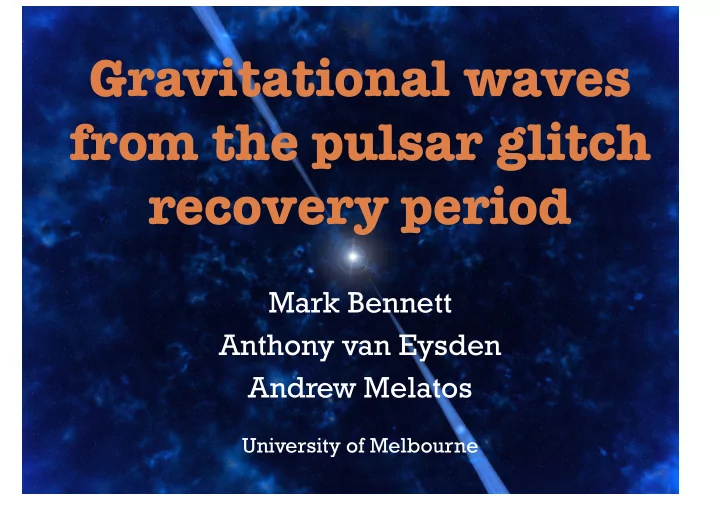

Gravitational waves from the pulsar glitch recovery period Mark Bennett Anthony van Eysden Andrew Melatos University of Melbourne
Overview Different types of signal from a pulsar glitch Calculate GW signal using simple model of a glitch Estimate signal-to-noise ratio for ET Compare the conventional and xylophone configurations for a glitch search Blind searches for unseen glitches Determine properties of interior from observations
Pulsars and glitches Rapidly rotating neutron stars “Lighthouse effect” Extremely accurate timing of pulses (up to 1 part in 10 15 ) Occasional timing irregularities: glitches 10 -11 < δΩ / Ω < 10 -4
Anatomy of a glitch Recovery Spin up Spin ( < 40s) ( ~ days/weeks) (Peralta 2006)
Types of GW signal Burst Signal (< 40 sec) Continuous Signal (days/weeks) Microphysics (inhomogeneous Macrophysics (nonaxisymmetric vortex rearrangement) circulation during relaxation)
Glitch model Model NS as cylinder with solid crust, fluid interior allows analytic solutions, stratification Glitch: step increase in crust Ω → Ω + δΩ Interior is spun up to match crust via the process of Ekman pumping Nonaxisymmetric interior spin-up flow → GW
Continuous GW signal Signal at f * and 2 f * 10 -25 Continuous source wave strain h(t) long decay time-scale coherent integration 0 increased signal-to-noise Contains information -10 -25 1 0.6 0.8 0 0.2 0.4 about the properties of time t / t E the pulsar interior
Detectability with ET Conventional ET Characteristic wave strain buoyancy Signal-to-noise ratio for integration over glitch compressibility Xylophone ET recovery period f * = 100 Hz buoyancy δΩ / Ω = 2 × 10 -4 distance = 1 kpc compressibility
LIGO (for comparison) Initial LIGO Advanced LIGO buoyancy AdvLIGO (NS optimised) AdvLIGO (BH optimised) buoyancy compressibility compressibility
Conventional vs xylophone ET
Detectability Concerns h 0 ∝ f * 3 → more common, low frequency glitches have smaller wave strain Larger frequency derivative than usual during relaxation period
Blind Search Around 300 glitches observed from ~ 100 pulsars (out of the ~ 2000 pulsars known) Estimated galactic population of 10 9 neutron stars, closest expected at distance of 8 pc Must be nearby, unseen glitches that are detectable (maybe even with LIGO currently?) Difficult to search for: unknown position, relaxation, and timing of event (however SKA, etc in future…?)
Nuclear properties from GW signal Extract properties of bulk nuclear matter in buoyancy neutron star interior compressibility viscosity compressibility buoyancy inclination angle compressibility Contours of constant amplitude ratio (blue) and width ratio (red) of Fourier spectrum peaks at f * and 2f * for plus polarisation. Inclination angle
Terrestrial Experiments Neutron radius measurements for lead (PREx) Heavy-ion collisions (RHIC) Viscosity ~ quantum lower bound
Summary Continuous gravitation radiation during glitch recovery period Estimate signal-to-noise ratio for ET → large glitches detectable Many nearby, unseen glitches with strong signals Learn new information about pulsar interior from future GW observations
Recommend
More recommend